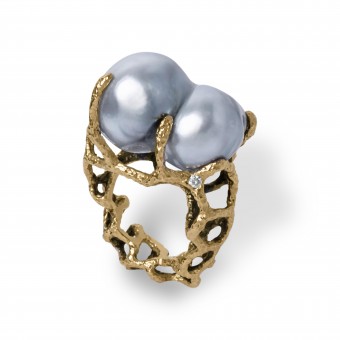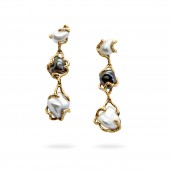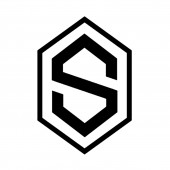Fissure Jewellery by Lingjun Sun |
Home > Winners > #120295 |
 |
|
||||
| DESIGN DETAILS | |||||
| DESIGN NAME: Fissure PRIMARY FUNCTION: Jewellery INSPIRATION: 'Fissure' is a collection inspired by the crevices in melting ice caps and dried earth, echoing the growing environmental crisis we are living in. UNIQUE PROPERTIES / PROJECT DESCRIPTION: Each piece of this collection is hand-carved into a three dimensional lattice with lines mimicking those found in nature - a technique developed in my MA program in London. A thoughtful design logic hides between the organic lines of each piece, forming accordingly around the gems, contributing to balanced compositions of seemingly random components. OPERATION / FLOW / INTERACTION: The designs were inspired the crevices in melting ice caps and dried earth. Wearers are experiencing the organic, three dimensional and asymmetrical forms of the collection. Its crisscrossing structure is further highlighted by colour contrast. Smooth and lustrous gems sitting in a carefully textured surface of the metal implies the incongruity human civilization and the nature. PROJECT DURATION AND LOCATION: The project started in August 2020 in Sydney, and was exhibited in NYC Jewellery Week 2020 |
PRODUCTION / REALIZATION TECHNOLOGY: Each piece was hand-carved from wax to create the structure, according to the design needs or specific gem shapes. Lost-wax casting was used later. Stone setting, metal finishing and black rhodium plating were also applied. 18K yellow gold, south sea baroque pearls, white diamonds. SPECIFICATIONS / TECHNICAL PROPERTIES: Ring No.1: 41mm x 27mm x 19mm; Earrings No.1: 32mm x 32mm x 7mm; Earrings No.2: 55mm x 14mm x 11mm TAGS: wearable sculpture, art jewellery, one of a kind, volume, asymmetry RESEARCH ABSTRACT: Extracting a two dimensional pattern that widely found in nature to a three dimensional form requires large scale of visual analysis and model construction. Carefully designed structure, texture and colour, together serve the design logic hidden behind these seemingly random lines. CHALLENGE: Seemingly randomness, asymmetrical structure, fine surface texture, together with unique form of each piece in the collection made 2D rendering or computer tools nearly impossible. Every piece required significant time and carving craftsmanship to model and test in physical prototypes. Further detailed adjustment was processed with additional remarkable time and effort. ADDED DATE: 2021-02-25 05:30:01 TEAM MEMBERS (1) : IMAGE CREDITS: Image#1, 2, 3, 4: Photographer Charmaine Morgan, 2020, Image#5: Photographer Lingjun Sun, 2021 |
||||
| Visit the following page to learn more: http://www.lingjunsun.com/ | |||||
| AWARD DETAILS | |
 |
Fissure Jewellery by Lingjun Sun is Winner in Jewelry Design Category, 2020 - 2021.· Read the interview with designer Lingjun Sun for design Fissure here.· Press Members: Login or Register to request an exclusive interview with Lingjun Sun. · Click here to register inorder to view the profile and other works by Lingjun Sun. |
| SOCIAL |
| + Add to Likes / Favorites | Send to My Email | Comment | Testimonials | View Press-Release | Press Kit |
Did you like Lingjun Sun's Jewelry Design?
You will most likely enjoy other award winning jewelry design as well.
Click here to view more Award Winning Jewelry Design.








